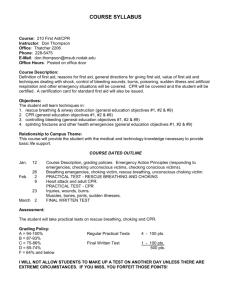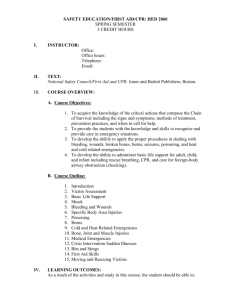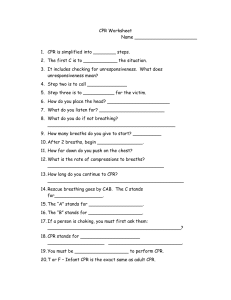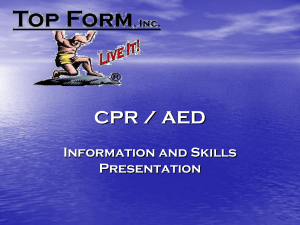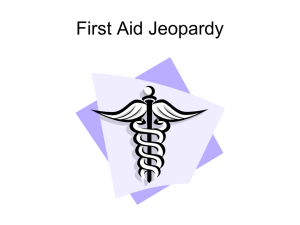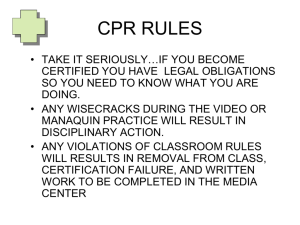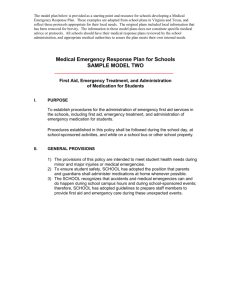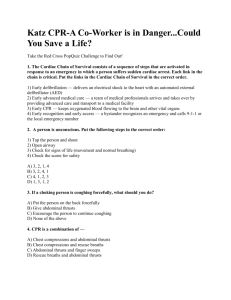WebExpo Presentation on the Guideline Changes
advertisement
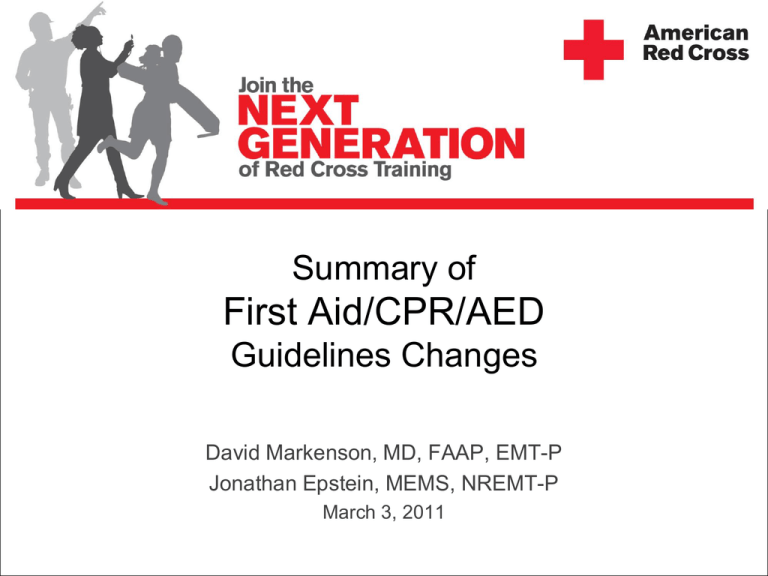
Summary of First Aid/CPR/AED Guidelines Changes David Markenson, MD, FAAP, EMT-P Jonathan Epstein, MEMS, NREMT-P March 3, 2011 Housekeeping • Questions will be answered during live chat at 2 pm ET in the Networking Lounge • Click on the “expand” button to enlarge the slides • Click on the “files” button to download the presentation • This presentation will be available on demand and as a podcast for the next 3 months ECC Revisions Overview • Every 5 years experts from around the world review first aid and emergency care procedures • The goal is to determine if any new discoveries affect the way care is delivered • Guidelines and program materials are updated accordingly Red Cross Scientific Advisory Council • Multi-disciplinary panel comprised of more than 30 volunteer professionals • The goal of the Council is to assure that Red Cross courses, training materials and products utilize the latest scientific and technical information available CPR: The Big Picture . . . – Emphasis on quickly getting to compressions for anyone in cardiac arrest – Rescue breaths remain important for infants and children and others with respiratory emergencies By-standers • Hands-Only CPR – For witnessed sudden collapse of any person – Step of opening the airway eliminated – Check for responsiveness, call 9-1-1, and quickly look for breathing. If no breathing, give continuous chest compressions. Push hard and fast in the middle of the chest. Workplace Responders (OSHA-compliant) • Full CPR: Adults – Initial 2 rescue breaths eliminated • Full CPR: Children and Infants – Retain 2 initial rescue breaths with the exception of a witnessed sudden collapse in which case you would skip the 2 initial rescue breaths Professional Rescuers • Full CPR – Emphasis on quickly checking for breathing and a pulse – Rescue breathing skill retained – For adults, initial 2 ventilations (rescue breaths) eliminated Workplace and Professional Rescuers • CPR Technique – For children, use 2 hands and compress the chest about 2 inches – For infants, compress the chest about 1½ inches Workplace and Professional Responders • AEDs – AED protocols remain the same – Use an AED as soon as possible Professional Rescuers • Giving Ventilations/Using a BVM – This should only be done as a 2-person skill First Aid: Medical Emergencies • Epi – A second dose of an epinephrine auto-injector should be given if signals of anaphylaxis persist after a few minutes and advanced medical care is delayed • Positioning – Simplified approach to positioning a person who is unconscious, but breathing. Generally, the person should not be moved from a face-up position • Shock – It’s best to leave the person lying flat and not elevate the legs First Aid: Environmental Emergencies • Heatstroke – Rapid cooling for heat stroke by cold water immersion is preferred method with carbohydrate-electrolyte solutions recommended for rehydration • Frostbite – Care for minor frostbite can be as simple as rewarming by skin-to-skin contact; with warm water immersion recommended for more serious frostbite First Aid: Environmental Emergencies • Bites – Care for any venomous snake bite is now the same and includes a pressure immobilization bandage – Irrigation of animal or human bites with large amounts of clean water or saline can minimize the risk of infection – Use vinegar to prevent further envenomations followed by hot water immersion for reducing pain. If hot water is not available, pack with sand First Aid: Injuries • Bleeding – Direct pressure continues to be the most effective method of control • Tourniquets – Can be used as a last resort if direct pressure fails, is not possible or where response from EMS is delayed • Topical hemostatic agents – Can be considered at the professional rescuer level if direct pressure and tourniquets are not possible First Aid: Injuries • Spinal injuries – Manually support the head and neck in the position found without movement or alignment with the body, except in the case of compromised airway • Muscle/bone/joint injuries – Use RICE (Rest, Immobilize, Cold and Elevate). Angulated fractures should not be straightened Live Chat: Ask the Experts Participate in a live chat about the science changes with Red Cross experts who helped craft the new guidelines. • Networking Lounge: 2 pm ET • Experts: Dr. Eunice Singletary and Dr. Andrew MacPherson


